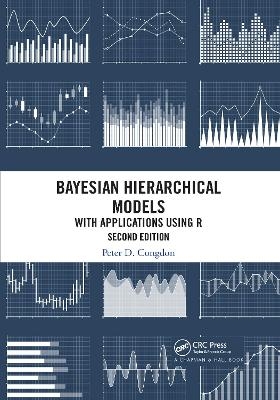
Bayesian Hierarchical Models
With Applications Using R, Second Edition
Seiten
2021
|
2nd edition
Chapman & Hall/CRC (Verlag)
978-1-032-17715-1 (ISBN)
Chapman & Hall/CRC (Verlag)
978-1-032-17715-1 (ISBN)
This is the second edition of a book on applied Bayesian modelling using WinBUGS. It has been updated with a new chapter on regression for causal effects, and one on computing options and strategies.
An intermediate-level treatment of Bayesian hierarchical models and their applications, this book demonstrates the advantages of a Bayesian approach to data sets involving inferences for collections of related units or variables, and in methods where parameters can be treated as random collections. Through illustrative data analysis and attention to statistical computing, this book facilitates practical implementation of Bayesian hierarchical methods.
The new edition is a revision of the book Applied Bayesian Hierarchical Methods. It maintains a focus on applied modelling and data analysis, but now using entirely R-based Bayesian computing options. It has been updated with a new chapter on regression for causal effects, and one on computing options and strategies. This latter chapter is particularly important, due to recent advances in Bayesian computing and estimation, including the development of rjags and rstan. It also features updates throughout with new examples.
The examples exploit and illustrate the broader advantages of the R computing environment, while allowing readers to explore alternative likelihood assumptions, regression structures, and assumptions on prior densities.
Features:
Provides a comprehensive and accessible overview of applied Bayesian hierarchical modelling
Includes many real data examples to illustrate different modelling topics
R code (based on rjags, jagsUI, R2OpenBUGS, and rstan) is integrated into the book, emphasizing implementation
Software options and coding principles are introduced in new chapter on computing
Programs and data sets available on the book’s website
An intermediate-level treatment of Bayesian hierarchical models and their applications, this book demonstrates the advantages of a Bayesian approach to data sets involving inferences for collections of related units or variables, and in methods where parameters can be treated as random collections. Through illustrative data analysis and attention to statistical computing, this book facilitates practical implementation of Bayesian hierarchical methods.
The new edition is a revision of the book Applied Bayesian Hierarchical Methods. It maintains a focus on applied modelling and data analysis, but now using entirely R-based Bayesian computing options. It has been updated with a new chapter on regression for causal effects, and one on computing options and strategies. This latter chapter is particularly important, due to recent advances in Bayesian computing and estimation, including the development of rjags and rstan. It also features updates throughout with new examples.
The examples exploit and illustrate the broader advantages of the R computing environment, while allowing readers to explore alternative likelihood assumptions, regression structures, and assumptions on prior densities.
Features:
Provides a comprehensive and accessible overview of applied Bayesian hierarchical modelling
Includes many real data examples to illustrate different modelling topics
R code (based on rjags, jagsUI, R2OpenBUGS, and rstan) is integrated into the book, emphasizing implementation
Software options and coding principles are introduced in new chapter on computing
Programs and data sets available on the book’s website
Peter Congdon is Research Professor in Quantitative Geography and Health Statistics at Queen Mary, University of London.
Contents
Preface
1. Bayesian Methods for Complex Data: Estimation and Inference
2. Bayesian Analysis Options in R, and Coding for BUGS, JAGS, and Stan
3. Model Fit, Comparison, and Checking
4. Borrowing Strength via Hierarchical Estimation
5. Time Structured Priors
6. Representing Spatial Dependence
7. Regression Techniques Using Hierarchical Priors
8. Bayesian Multilevel Models
9. Factor Analysis, Structural Equation Models, and Multivariate Priors
10. Hierarchical Models for Longitudinal Data
11. Survival and Event History Models
12. Hierarchical Methods for Nonlinear and Quantile Regression
| Erscheinungsdatum | 01.10.2021 |
|---|---|
| Zusatzinfo | 70 Illustrations, black and white |
| Sprache | englisch |
| Maße | 178 x 254 mm |
| Gewicht | 453 g |
| Themenwelt | Mathematik / Informatik ► Mathematik |
| Naturwissenschaften ► Biologie | |
| ISBN-10 | 1-032-17715-2 / 1032177152 |
| ISBN-13 | 978-1-032-17715-1 / 9781032177151 |
| Zustand | Neuware |
| Haben Sie eine Frage zum Produkt? |
Mehr entdecken
aus dem Bereich
aus dem Bereich
Von Logik und Mengenlehre bis Zahlen, Algebra, Graphen und …
Buch | Softcover (2024)
De Gruyter Oldenbourg (Verlag)
CHF 104,90
fundiert, vielseitig, praxisnah
Buch | Softcover (2021)
Springer Berlin (Verlag)
CHF 46,15
Analysis und Lineare Algebra mit Querverbindungen
Buch | Hardcover (2022)
Springer Spektrum (Verlag)
CHF 89,95


